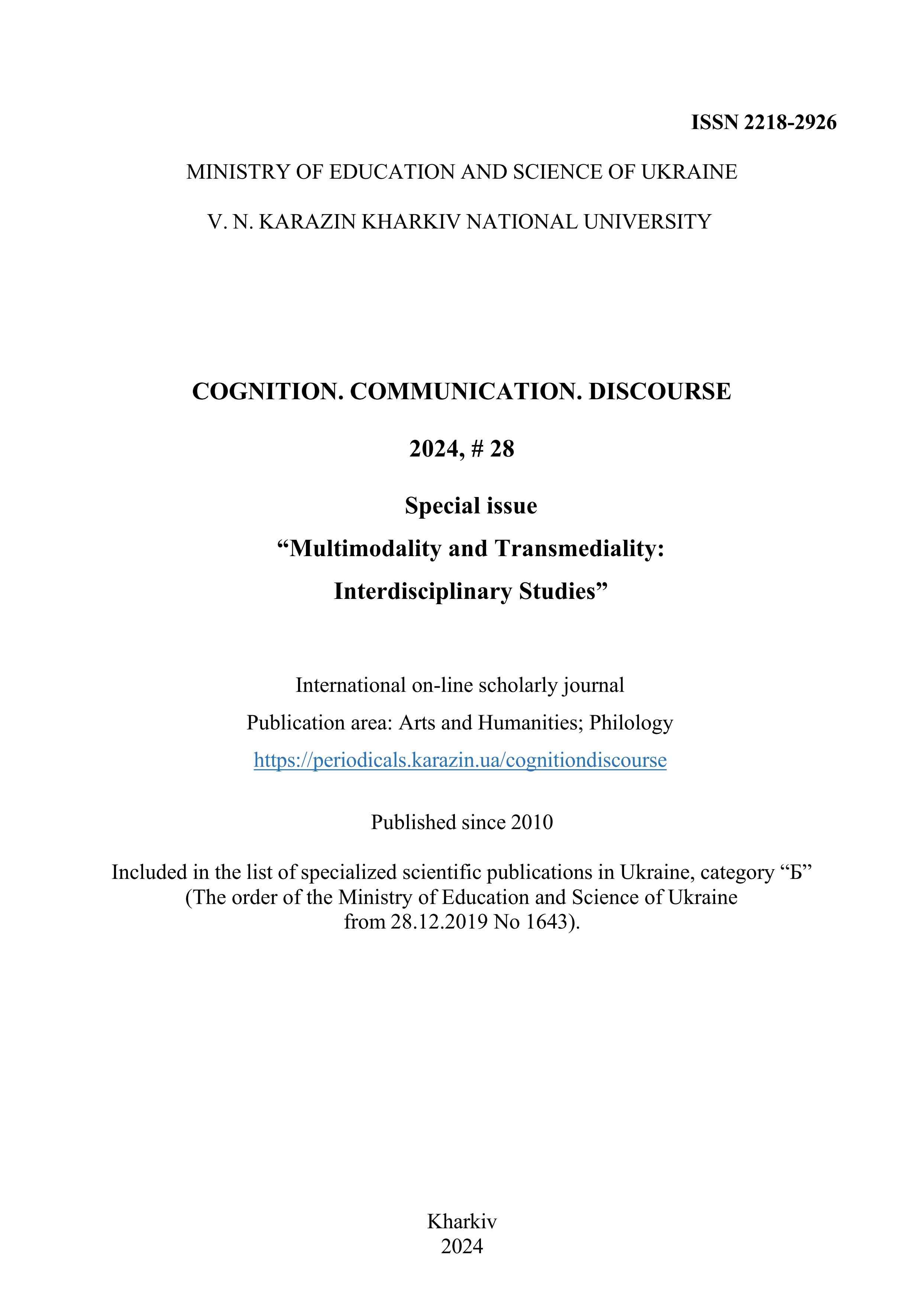An intermedial perspective for ekphrasis: How photographs contribute to writing about artists
Abstract
This paper examines the relationships that emerge in the process of meaning-making in the anthology Writers on artists (Minton, 2001) between photographic portraits of the artists and other images and verbal textual components. The findings demonstrate that as indexes, the photographs of the artists testify to the artists’ real existence; as icons, these photographs contribute to the representation of the artists’ uniqueness. Through these two roles, the artists’ photographic portraits ensure the status of the ekphrasis in the essays as “actual ekphrasis” (in Hollander’s terms). In interaction with the biographical notes, the photographs of the artists highlight their uniqueness. As elements in the multimodal complexes “artist’s photo & artist’s bio”, the artists’ photographs enter into the relationships of similarity and contrast with the writers’ photographs in the multimodal complexes “writer’s photo & writer’s bio”, which are instrumental in creating symbolic dialogic space for the discussion of the works of the visual arts in the essays. Those photographs that are photographs of the artists’ painted or drawn portraits rather than people themselves establish strong semantic links with descriptive ekphrasis. Some of the objects captured in the artists’ photographs can contribute to descriptive ekphrasis. Those photographic portraits that offer psychological characterization of the artists work in synchrony with interpretative ekphrasis. The photographs that can symbolically evoke schemata of knowledge which have high relevance for ekphrastic interpretations and metaekphrastic discussions strongly support meanings generated in the essays. The photographs that are likely to be interpreted symbolically contribute most significantly to the meaning-making in the essays.
Downloads
References
Barthes, B. (1981). Camera lucida: Reflections on photography. New York, NY: Hill and Wang.
Böger, A. (2015). Twentieth-century American literature and photography. In G. Rippl (Ed.), Handbook of intermediality (pp. 173-192). Berlin, München, Boston: De Gruyter. https://doi.org/10.1515/9783110311075-011
Bruhn, J., & Schirrmacher, B. (2022). Intermedial studies. In J. Bruhn & B. Schirrmacher (Eds), Intermedial studies. An introduction to meaning across media (pp. 3-27). London and New York, NY: Routledge. https://doi.org/10.4324/9781003174288-2
Carrier, D. (1987). Ekphrasis and interpretation: two modes of art history writing. British journal of aesthetics, 27(1), 20-31. https://doi.org/10.1093/bjaesthetics/27.1.20
Clüver, C. (2007/2016). Intermediality and interarts studies. In J. Arvidson, M. Askander, J. Bruhn, & H. Führer (Eds.), Changing borders: Contemporary positions in intermediality (pp. 19-37). Lund: Intermedia Studies Press.
Eco, U. (1984). Semiotics and the philosophy of language. Bloomington, IN: Indiana University Press.
Elleström, L. (2021). The modalities of media II: An expanded model for understanding intermedial relations. In L. Elleström (Ed.), Beyond media borders, Volume 1. Intermedial relations among multimodal media (pp. 3-91). London: Palgrave Macmillan. https://doi.org/10.1007/978-3-030-49679-1_1
Elsner, J. (2002). Introduction: The genres of ekphrasis. Ramus, 31(1-2), 1-18. https://doi.org/10.1017/S0048671X00001338
Fjellestad, D. (2015). Nesting – braiding – weaving: Photographic interventions in three contemporary American novels. In G. Rippl (Ed.), Handbook of intermediality: Literature – image – sound – music (pp. 193-218). Berlin, München, Boston, MA: De Gruyter.
Freeland, C. (2007). Portraits in painting and photography. Philosophical Studies, 135, 95-109. https://doi.org/10.1007/s11098-007-9099-7
Gavins, J., & Steen, G. (Eds.). (2003). Cognitive poetics in practice. London and New York, NY: Routledge.
Heffernan, J. A.W. (1991). Ekphrasis and representation. New Literary History, 22(2), 297-316.
Horstkotte, S. (2017) Ekphrasis as genre, ekphrasis as metaphenomenology In R. Bodola & G. Isekenmeier (Eds.), Literary visualities: Visual descriptions, readerly visualisations, textual visibilities (pp. 127-164). Berlin, Boston, MA: De Gruyter. https://doi.org/10.1515/9783110378030-005
Koopman, N. (2014). Ancient Greek ekphrasis: Between description and narration [Doctoral dissertation, University of Amsterdam]. https://dare.uva.nl/search?identifier=511a0974-315e-4072-b9fe-c9314c99ce68
Krieger, M. (2019). Ekphrasis: The illusion of the natural sign. Baltimore, MD: John Hopkins University Press. https://doi.org/10.1353/book.68495
Lefebvre, M. (2002). Photography and semiotics: Use and purpose. Critical inquiry, 48(4), 742-773. https://doi.org/10.1086/719852
Mitchell, W. J. T. (1994). Ekphrasis and the other. Picture theory: Essays on verbal and visual representation. Chicago, IL: The University of Chicago Press. Retrieved from https://complit.utoronto.ca/wp-content/uploads/COL1000-Week11-Nov25_WJT_Mitchell.pdf
Rajewsky, I. O. (2005). Intermediality, intertextuality, and remediation: A literary perspective on itermediality. Intermédialités, 6, 43-64. https://doi.org/10.7202/1005505ar
Semino, E. (1995). Schema theory and the analysis of text worlds in poetry. Language and Literature, 4(2), 79-108. https://doi.org/10.1177/096394709500400201
Sontag, S. (1977/2019). On photography. London: Penguin Books.
Stockwell, P. (2002). Cognitive poetics. An introduction. London and New York, NY: Routledge.
Straub, J. (2015). Nineteenth-century literature and photography. In G. Rippl (Ed.), Handbook of intermediality: Literature – image – sound – music (pp. 156-172). Berlin, München, Boston, MA: De Gruyter.
Vorobyova, O., & Lunyova, T. (2020). Verbal and non-verbal facets of metaekphrastic writing: A cognitive study of John Berger’s essays on visual art. Lege artis. Language yesterday, today, tomorrow. The journal of University of SS Cyril and Methodius in Trnava, V(2), 335‒381.
Copyright (c) 2024 Tetyana Lunyova

This work is licensed under a Creative Commons Attribution-NonCommercial-NoDerivatives 4.0 International License.
Authors, who publish with this journal, accept the following conditions:
The authors reserve the copyright of their work and transfer to the journal the right of the first publication of this work under the terms of the Creative Commons Attribution Non-Commercial Non-Derivs License (CC BY-NC-ND), which allows other persons to freely distribute a published work with mandatory reference to the authors of the original work and the first publication of the work in this journal.
Authors have the right to enter into separate additional agreements for the non-exclusive dissemination of the work in the form in which it was published by this journal (for example, to post the work in the electronic institutions' repository or to publish as part of a monograph), provided that the link to the first publication of the work in this journal is given.
The journal policy allows and encourages the authors to place the manuscripts on the Internet (for example, in the institutions' repositories or on personal websites), both before the presentation of this manuscript to the editorial board and during review procedure, as it contributes to the creation of productive scientific discussion and positively affects the efficiency and dynamics of citing the published work (see The Effect of Open Access).




